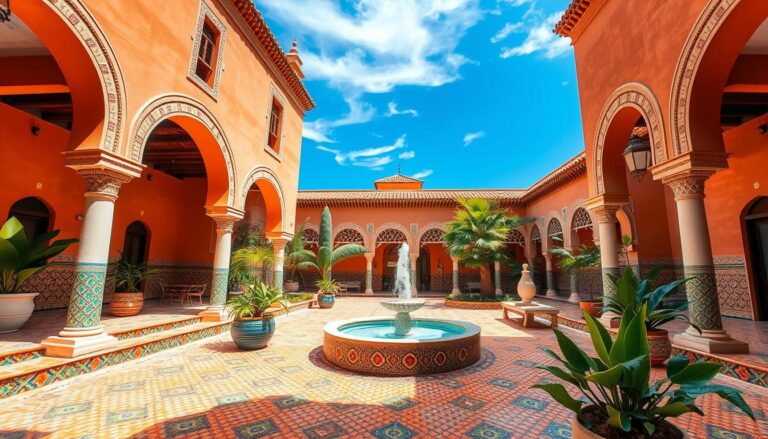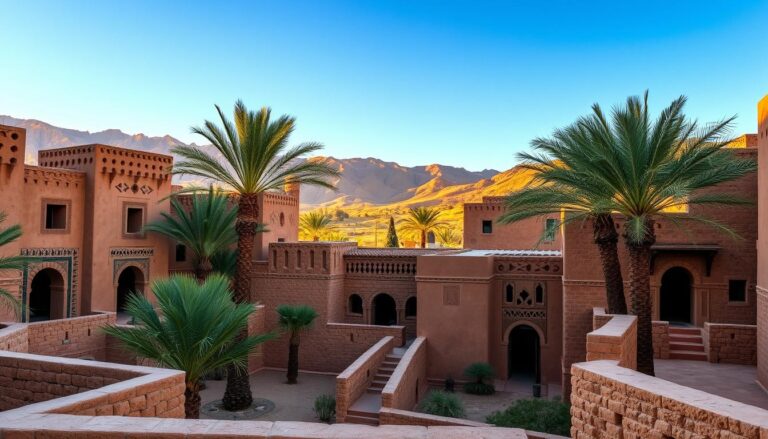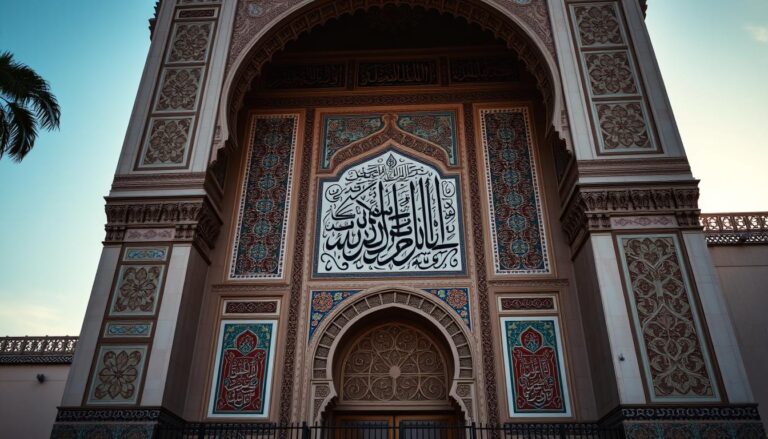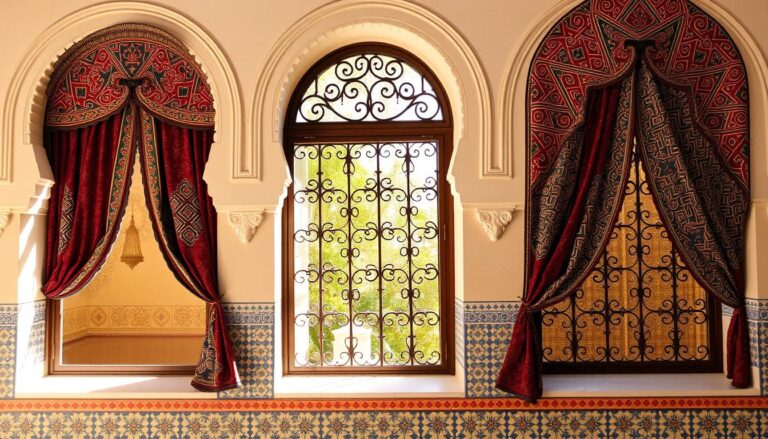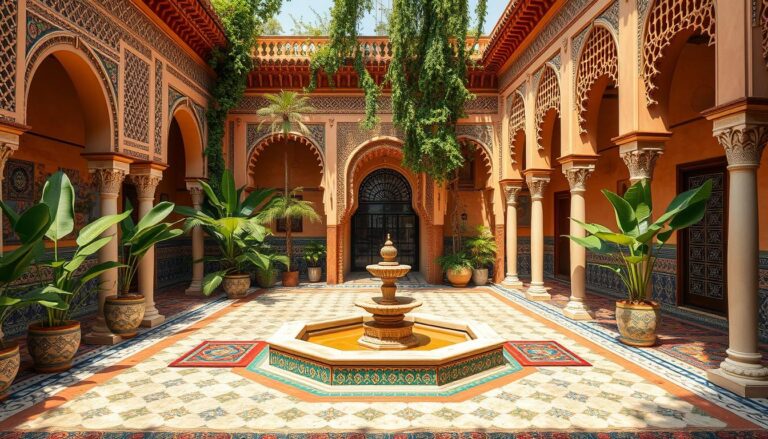Why is the horseshoe arch so special in Moroccan architecture? It’s found in the grand entrances of riads and the detailed tile work of courtyards. This unique arch shape is a key part of Morocco’s design history. But where did it come from, and how did it become so important in Moroccan culture?
Key Takeaways
- The horseshoe arch, also known as the Moorish arch, has pre-Islamic origins dating back to Sasanian and Byzantine architecture.
- Horseshoe arches were also used in early Christian architecture of the Iberian Peninsula, showcasing their widespread influence.
- In Islamic architecture, the horseshoe arch developed its characteristic form in the Al-Andalus and Maghreb regions.
- Horseshoe arches hold symbolic meaning in Moroccan design, believed to provide protection against the evil eye and bring good fortune.
- The versatility of arch forms, from pointed to scalloped, adds to the rich tapestry of Moroccan architectural styles.
The Origins and Early History of Horseshoe Arches
The horseshoe arch has a long history, starting before Islam. It was seen in Sasanian and Byzantine buildings. The Taq-i Kasra in Iraq and the Palace of Ardashir in Iran are examples from the 3rd century CE.
This design also showed up in Late Roman and Byzantine architecture. It was also used in Christian buildings in the Iberian Peninsula before Islam. Early examples include the Baptistery of Saint Jacob in Byzantine Syria and Qasr Ibn Wardan in Syria, from the 4th and 6th centuries CE.
Pre-Islamic Origins in Sasanian and Byzantine Architecture
The horseshoe arch comes from the Sasanian Empire, which was in Persia from the 3rd to 7th centuries CE. The Taq-i Kasra in Iraq and the Palace of Ardashir in Iran are clear examples.
Early Uses in Christian Architecture of the Iberian Peninsula
The horseshoe arch was also used in Christian buildings in the Iberian Peninsula before Islam. The Visigoths, a Germanic people, used this design in their buildings.
“The horseshoe arch, a characteristic feature of Arab Mediterranean monuments, was found in preserved buildings from the Visigoth period in Spain.”
The Mosque of Cordoba is a key example of Spanish Arab style. It uses many reliefs, friezes, and capitals from old Visigoth structures. This shows the lasting impact of pre-Islamic architecture.
The Distinctive Moorish Horseshoe Arch
The Islamic architecture of Al-Andalus (the Iberian Peninsula) and the Maghreb (North Africa) is famous for the Moorish horseshoe arch. It started in the Emirate period. The Umayyads of Al-Andalus used it a lot, often adding an alfiz (rectangular frame) to highlight its shape.
Development in Al-Andalus and the Maghreb
The Córdoban style of horseshoe arch spread far, adopted by Muslim emirates and the Maghreb. It became a key feature of Moorish design. You can see it in places like the Great Mosque of Cordoba and Medina Azahara.
The Caliphal Style and Almohad Pointed Arches
In the Almoravid and Almohad periods, the pointed horseshoe arch became even more common. It likely came from North Africa. This Caliphal style of Almohad pointed arches made Moorish architecture even more unique.
“The Distinctive Moorish Horseshoe Arch is notable for first Islamic use in the horseshoe arch at the Great Mosque of Cordoba, further prominent in other architectural masterpieces.”
These examples show how important the horseshoe arch is in Islamic West architecture. They reflect the cultural exchange and innovation in Al-Andalus and the Maghreb.
Horseshoe Arches in Moroccan Riads and Courtyards
Moroccan architecture is known for its detailed and beautiful designs. The horseshoe arch is a key feature of this tradition. These arches are more than just structures; they help create the peaceful spaces found in traditional Moroccan riads.
Riads, the typical Moroccan homes, have central courtyards that are the heart of the house. The horseshoe arch is everywhere, from entrances to furniture. It makes the riad feel connected and peaceful.
The influence of the Moors on Moroccan architecture is clear in the horseshoe arches. They came from pre-Islamic designs. Over time, they became a symbol of Moorish architecture in North Africa and the Iberian Peninsula.
“The horseshoe arch is not just a structural element, but a symbolic representation of the harmony and balance that defines Moroccan riad design.”
In Moroccan courtyards, horseshoe arches mark the transition between inside and outside. They also offer shaded areas for rest and socializing.
The use of horseshoe arches in Moroccan riads and courtyards shows the lasting impact of Moorish design. This feature still draws visitors and inspires new takes on Moroccan style.
Symbolism and Meaning of Horseshoe Arches
Protection and Good Fortune Symbolism
The horseshoe arch in Moroccan design is more than just pretty. It carries deep symbolic meaning. In Moroccan culture, the horseshoe is seen as a shield against the evil eye and a symbol of good luck.
This belief comes from the Berber tribes and early Muslims in Morocco. They placed horseshoes above doors to keep evil away and bring luck into homes. The horseshoe’s curved shape was thought to have magical powers. It was believed to protect people from harm and draw in good vibes.
“The horseshoe arch, with its distinctive curved shape, was believed to possess mystical properties that could shield the occupants from negative forces and attract positive energy into the living space.”
The horseshoe arch also made Moroccan and Moorish design stand out. It added grandeur and beauty to entryways and courtyards. It showed the strong cultural traditions and beliefs of Moroccan designers.
The horseshoe arch remains popular today in Moroccan design. It shows the lasting power of its symbolism and the rich culture of the region. It adds a touch of Moroccan charm to both traditional and modern spaces.
Horseshoe arches in Moroccan design
The horseshoe arch is key in Moroccan architecture. You see it everywhere in traditional homes and buildings. It’s used for doors, windows, and even in decorations.
These arches, along with others like pointed and scalloped, make Moroccan design unique. They add beauty and harmony to buildings and homes. This shows the skill and variety in Moroccan architecture.
“The variety of arches and their decorations demonstrate the sophistication and diversity of Moroccan architectural design.”
Arches play a big role in Moroccan buildings. They look good and help hold things up. The horseshoe arch is especially important, with roots in old Muslim beliefs. It’s meant to keep evil away and bring good luck.
Over time, arches in Moroccan design have changed a lot. They started simple and got more complex. This change shows Morocco’s deep architectural history. Different arch styles add to the beauty of Moroccan buildings.
Variations and Decorative Styles
Moroccan architecture is known for its wide range of arch designs and decorative styles. It goes beyond the famous horseshoe arch. Each arch has its own special look and meaning.
Ogee, Scalloped, and Multifoil Arches
The ogee arch adds elegance with its curved shape. The scalloped arch looks like a shell and brings a playful feel. The multifoil arch uses shapes like trefoils, making it very symbolic.
These Moroccan arch variations and the ornate decorative arches show the country’s love for detail. Techniques like carved stucco and intricate tilework make these archways stunning.
“The sheer variety of arch designs, along with the intricate carving and ornamentation that often adorns them, exemplifies the sophistication and attention to detail that characterizes Moroccan architectural aesthetics.”
From the tall multifoil arches in mosques to the cozy scalloped arches in riads, Moroccan design is rich and varied. It shows a deep cultural tradition that draws people from everywhere.
Conclusion
The horseshoe arch is key to Moroccan design, with roots in ancient Sasanian and Byzantine styles. It also appeared in early Christian architecture of the Iberian Peninsula. But it truly flourished in Islamic architecture of Al-Andalus and the Maghreb, becoming a hallmark of Moroccan design.
Today, the horseshoe arch is a staple in Moroccan architecture, especially in traditional riads. It shows Morocco’s deep cultural heritage and the lasting effects of Islamic and Moorish styles. This arch is found everywhere, from grand mosques to cozy homes.
The horseshoe arch and other Moroccan architectural features still amaze people today. From the Hassan II Mosque in Casablanca to the Bahia Palace in Marrakech, they inspire many. As Moroccan architecture grows, the horseshoe arch stays a symbol of the country’s rich culture and global design influence.
Source Links
- The emblematic Moroccan arch
- Horseshoe arch
- From Islamic to Art Deco: A rich history of Moroccan architecture
- Moroccan architecture
- Horseshoe arch – The Artistic Adventure of Mankind
- The Rich and Vibrant History of Moroccan Architecture.
- Moorish architecture | For UNESCO World Heritage Travellers
- Exploring the Richness of Moroccan Architecture – Cindrebay
- Horseshoe Arch – Art of Islamic Pattern
- Moorish architecture
- What Type of Architecture Is Morocco Known for?
- Bohemian & Morrocan Interior Design – The Ultimate Guide
- Arches and minarets
- Islamic art and symbolism | Symbolism in Art Class Notes | Fiveable
- Islamic arts – Moorish, Architecture, Decoration | Britannica
- Moroccan Art and Architecture, Traditional & Modern Styles
- Moroccan Style Interior Design by Mimar InteriorsArchiExpo
- Architectural Wonders of Morocco – Rahtours
- Moroccan Architectural Influence in Modern Interior Design
- Moroccan Interior Design with EVA.

The Editorial Team is a passionate group of Morocco enthusiasts dedicated to sharing the beauty, culture, and wonders of this captivating country. With diverse backgrounds and a deep love for travel, we strive to bring you engaging and informative content that inspires your Moroccan adventures. From uncovering hidden gems and sharing local insights to exploring mouthwatering cuisine and showcasing the vibrant lifestyle, our team is committed to providing you with valuable resources and exciting stories that enhance your exploration of Morocco. Join us on this journey as we celebrate the rich heritage and unforgettable experiences that make Morocco truly special.


